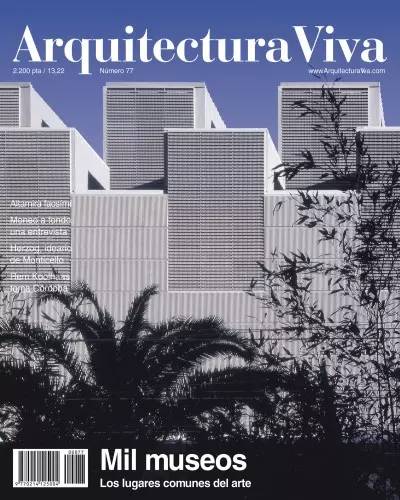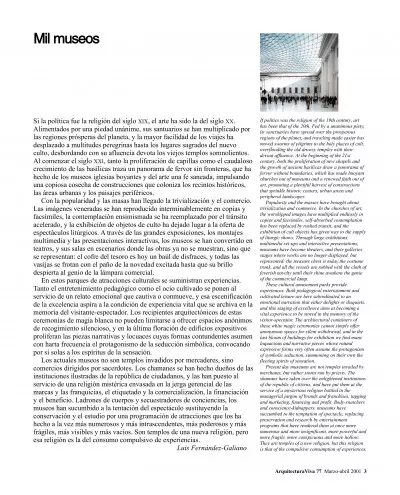Contents
A Thousand Museums. An account of the evolution of museums and their unstoppable growth through twelve projects: Pergamon, Berlin (Ungers); Galleria d’Arte, Rome (Diener & Diener), Art Museum, Ingolstadt (Gigon & Guyer); Rijksmuseum, Amsterdam (Cruz & Ortiz), Contemporary Arts Center, Cincinnati (Hadid); Hermitage-Guggenheim, Las Vegas (Koolhaas); Archaeological Museum, Vitoria (Mangado); Ibere Camargo, Porto Alegre (Siza); Primitive Arts Museum, Paris (Nouvel); Navigation Museum, Genoa (V. Consuegra); War Museum, Manchester (Libeskind); and Milwaukee Art Museum (Calatrava).
Synopses
Juan Antonio Ramírez
The Stage of Stories
Art and Architecture of Museums
Adela García-Herrera
Dialog in Three Frequencies
With Heritage
From the City
Before the Landscape
Twelve Projects Abridged
Buildings: Projects and Realizations
With Heritage. The renovation of the British Museum Central Court recovers a large public space for London; and the new museums housed in the imperial stables of Vienna revitalize this old historic ensemble.
From the City. With a vibrant metallic coffin and a dark stone box, peripheral cities such as Castellón and Vaduz hope to earn a spot in the map of museums, but also to become architectural poles of attraction.
Before the Landscape. The new buildings of the Dutch ethnography museum echoe constructional tradition; and the forms of the Cantabrian museum which houses the replica of a paleolithic cave offer lessons in topography.
Architecture
Norman Foster
British Museum, London
Ortner & Ortner
MuseumsQuartier, Vienna
Moreno Mansilla y Tuñón
Museum of Fine Arts, Castellón
Morger, Degelo y Kerez
Kunstmuseum, Vaduz
Mecanoo
Ethnographic Museum, Arnhem
Juan Navarro Baldeweg
Altamira Museum, Santillana
Books, Exhibitions, Personalities
Harvest of Prizes. The Mies prize has gone to Rafael Moneo for the Kursaal; and the Pritzker to Jacques Herzog and Pierre de Meuron. An interview and the award acceptance speech cover their respective professional careers. Art / Culture
Luis Fernández-Galiano
Interview with Rafael Moneo
Jacques Herzog
The Ideals of MonticelloFoundig Fathers. The Madrid exhibition on Mélnikov at the Arquerías Galleries and its catalog, and the display of Picasso’s series at the Reina Sofía Museum remind us of their role as founding fathers of the avant-garde. Josep Llinás
Regarding Mélnikov
Juan Antonio Ramírez
Kahn, the Timeless PresentDocumentary Arts. The reprint of a mythical book on Sullivan, and two recently published editions devoted to Mies and Taut show that photography is a valuable means to continue reviewing the legacy of modern masters.
Focho’s Cartoon
David Chipperfield
Various Authors
Books
Interiors, Design, Construction
A Linear Mosque. Veni, vidi, vici. Rem Koolhaas imposed himself on Cruz & Ortiz, Zaha Hadid, Toyo Ito and Rafael Moneo in the competition to build the Córdoba Congress Center on the left bank of the River Guadalquivir, in front of the historic center and in the Miraflores peninsula. And he achieved this through a venturesome maneuver which altered the site foreseen in the bases, proposing a gigantic linear block on pilotis where the different elements of the program succeed one another: visitors’ center, auditorium and hotel. Technique / Style
Luis Fernández-Galiano
News from Córdoba
The CCC Competition
Rem Koolhaas
Cruz y Ortiz
Zaha Hadid
ToyoIto
Rafael MoneoTo close, Paloma Acuña goes through some of the most recent Spanish museums, which serve as examples to identify the principal difficulties that affect the design of the buildings and the management of the collections. Products
Casa Barcelona, Computers
Paloma Acuña
Redundant Museums?
Luis Fernández-Galiano
Neonheart
If politics was the religion of the 19th century, art has been that of the 20th. Fed by a unanimous piety, its sanctuaries have spread over the prosperous regions of the planet, and traveling made easier has moved swarms of pilgrims to the holy places of cult, overflooding the old drowsy temples with their devout affluence. At the beginning of the 21st century, both the proliferation of new chapels and the growth of ancient basilicas draw a panorama of fervor without boundaries, which has made buoyant churches out of museums and a renewed faith out of art, promoting a plentiful harvest of constructions that sprinkle historic centers, urban areas and peripheral landscapes.
Popularity and the masses have brought about trivialization and commerce. In the churches of art, the worshipped images have multiplied endlessly in copies and facsimiles, self-absorbed contemplation has been replaced by rushed transit, and the exhibition of cult objects has given way to the supply of liturgic shows. Through large exhibitions, multimedia set-ups and interactive presentations, museums have become theaters, and their galleries stages where works are no longer displayed, but represented: the treasure chest is today the costume trunk, and all the vessels are rubbed with the cloth of feverish novelty until their shine awakens the genie of the commercial lamp.
These cultural amusement parks provide experiences. Both pedagogical entertainment and cultivated leisure are here subordinated to an emotional narration that either delights or disquiets, and this staging of excellence aims at becoming a vital experience to be stored in the memory of the visitor-spectator. The architectural containers of these white magic ceremonies cannot simply offer anonymous spaces for silent withdrawal, and in the last bloom of buildings for exhibition we find many loquacious and narrative pieces whose rotund expressive forms very often assume the protagonism of symbolic seduction, summoning on their own the fleeting spirits of sensation.
Present day museums are not temples invaded by merchants, but rather stores run by priests. The shamans have taken over the enlightened institutions of the republic of citizens, and have put them at the service of a mysterious religion bottled in the managerial jargon of brands and franchises, tagging and marketing, financing and profit. Body-snatchers and conscience-kidnappers, museums have succumbed to the temptation of spectacle, replacing preservation and research by entertainment programs that have rendered them at once more numerous and more insignificant, more powerful and more fragile, more conspicuous and more hollow. They are temples of a new religion, but this religion is that of the compulsive consumption of experiences.








